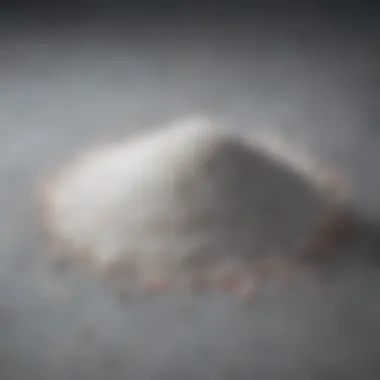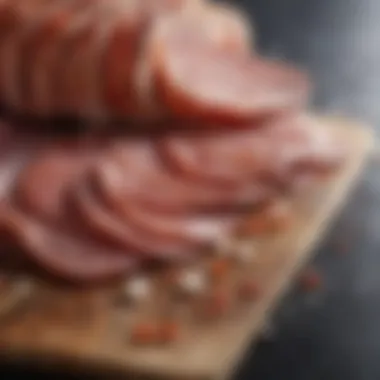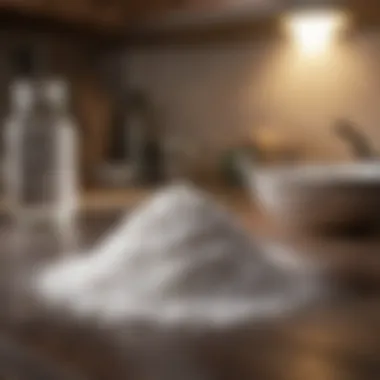Understanding Nitrite Curing Salt: A Comprehensive Guide


Intro
In the realm of food preservation and culinary arts, nitrite curing salt stands out as a vital component. It contributes significantly to the flavor and safety of cured meats, alongside its historical significance. Understanding its chemistry and applications provides crucial insights into how we can best use this compound in our cooking practices. This section serves as a gateway to explore the numerous facets of nitrite curing salt, preparing readers for a deeper dive into its intricacies.
Ingredients Breakdown
Nitrite curing salt consists of both primary and optional ingredients, serving distinct functions in the curing process. Recognizing these components plays a essential role in grasping their importance in culinary practices.
Primary Ingredients
Nitrite curing salt primarily includes sodium nitrite combined with regular table salt. The sodium nitrite focuses on inhibiting bacteria that can cause foodborne illnesses, particularly Clostridium botulinum. Furthermore, the blending with table salt ensures proper seasoning.
Optional Ingredients
Some formulations may contain dextrose or other preservatives. Dextrose, a simple sugar, aids in the fermentation process and contributes to the unique flavor profile of the finished product. Other optional ingredients can include added herbs or spices, enhancing taste while preserving.
Essential Kitchen Tools
The preparation of cured meats using nitrite curing salt demands specific tools. The most crucial tools include:
- Meat grinder: For those crafting ground foods.
- Food scale: Allows precise measurement of ingredients.
- Curing chamber or refrigerator: Essential for controlled curing processes.
- Vacuum sealer: Helps maximize preservation in variety of cured products.
Step-by-Step Preparation
Understanding how to prepare meats using nitrite curing salt extensively ensures proper application.
Prepping the Ingredients
Begin by selecting quality meat and preparing curing salt formulations. Accurate measurements incorporate safety and flavor. Use your food scale for precision. Mix primary and optional ingredients thoroughly, ensuring even distribution.
Cooking Techniques and Methods
Certain methods can affect the curing process. Traditional dry curing requires rubbing the salt blend into meat with a careful hand, while wet curing involves submersing meat in a brine. Equally, smoking enhances flavors while contributing to preservation but requires supervised heat control.
Assembly and Presentation Tips
After curing is complete, proper presentation is pivotal. Slicing meats thinly exposes flavors while allowing an artful arrangement on a board. Enhance visual appeal with herb garnishes or can serve alongside pickles, which complement tastes fittingly.
Dietary Considerations
Incorporating dietary needs represents crucial aspects of food preparation. Not all consumers can have typical offerings.
Gluten-Free Options
Most nitrite curing salts do not contain gluten. However, when preparing accompanying dishes, always double-check product labels to guarantee gluten-free choices.
Vegetarian and Vegan Substitutes
For adapting to non-meat diets, delve into plant-based alternatives. Commercial products using tempeh or tofu infused with similar flavors can yield satisfying results while maintaining functionality in preservation, thus marrying traditional techniques with new trends.
Nutrition Facts & Nutritional Considerations
Understanding nutritional content becomes essential. For example, sodium nitrite, present in nitrite curing salt, is regulated with safe usage levels. Additionally, a balanced approach and consideration of sodium intake remains accurate while preparing cured products.
Variations and Customizations
Variations enrich the experience of preparing cured meats, leading to enhanced culinary creativity.


Flavor Enhancements
Ingredients like garlic powder, bay leaf, and even liquid smoke can impart distinct flavors to cured meats. Experimenting leads to remarkable results that reflect personal tastes.
Alternative Cooking Methods
Sous-vide cooking allows for precise temperature control, which can enhance the moistness and flavor depth of cured products. This method, aimed at maintaining control, carries the potential to reshape traditional approaches.
Pairing Suggestions (Sides, Drinks, etc.
)
Successfully pairing cured meats heightens the experience. Consider savory cheeses, artisan breads, or crisp pickles as side companions. Ripe fruits also contrast flavor beautifully, something like a red wine aged well would nicely complement these dishes.
Common Questions and Answerss and Troubleshooting
Food enthusiasts often share questions regarding the use of nitrite curing salt. Understanding these informed inquiries can foster confidence in your culinary ventures.
Frequently Asked Questions
Common questions typically focus on safety, usage rates, or dietary impacts. Knowing the correct amount is vital; standard amounts drink per pound of meat vary.
Common Mistakes to Avoid
Failing to weigh the meat and salt correctly could result in improperly cured products. Avoid confusion at all costs during preparation stages.
Solutions to Potential Problems
If issues arise during the curing process—texture or flavor discrepancies—adjust formulations on the next iteration or conduct small experimental batches for further clarity.
Preface to Nitrite Curing Salt
Nitrite curing salt plays a critical role in the preparation of preserved meats and various culinary delights. This ingredient is favored within the food industry and home kitchens alike due to its unique properties and benefits. The significance of understanding nitrite curing salt extends beyond mere functionality in recipes; it encompasses the science behind food preservation and safety.
Curing salts contain nitrites, primarily sodium nitrite, which serve many pivotal purposes. Firstly, nitrites act as powerful preservatives, inhibiting the growth of harmful bacteria such as Clostridium botulinum. This bacterium can lead to botulism, a severe and sometimes fatal illness. Without the use of curing salts, meat products face heightened risk, both for producers and consumers.
Moreover, nitrites contribute to flavor development and color enhancement in cured meats. The process of curing goes beyond simply extending shelf life; it creates a distinctive taste and appealing appearance, which enhances products like salami, bacon, and deli meats. In this guide, we will outline the detailed aspects of nitrogen curing salt, elaborating how its chemistry interacts with meat, and how it impacts overall results achievements.
While nitrite curing salt is essential for meat preservation, certain health considerations must also be addressed. The chemical reactions that nitrites undergo can lead to the formation of nitrosamines, compounds linked to potential health risks. Understanding the complete spectrum, both benefits and risks, empowers readers to make informed decisions about their food choices.
With this framework, the nitrite curing salt serves as a bridge between culinary tradition and contemporary health concerns. By delving into its composition, historical significance, applications in the kitchen, and ways to use it safely, readers will acquire a comprehensive understanding of this vital ingredient in sia food preservation strategy. Whether one is a seasoned chef or a curious home cook, mastering this topic elevates one's culinary capabilities and enhances overall enjoyment of food.
Definition and Composition
The definition and composition of nitrite curing salt are essential to understanding its function and significance in food preservation. This ingredient facilitates preservation by inhibiting the growth of harmful bacteria, thereby ensuring food safety. Knowing its chemical makeup is vital for anyone interested in the culinary arts, especially those dedicated to the preparation of cured products. The precision in using nitrite curing salt cannot be overstated; even minute discrepancies in ratios can have large implications on food safety and flavor.
Chemical Makeup of Nitrite Curing Salt
Nitrite curing salt typically contains sodium nitrite as its primary compound. Sodium nitrite is responsible for giving cured meats their characteristic color and flavor. The typical composition may also include some sodium chloride. In chemistry, it is recognized for its function as both a preservative and an antioxidant. This aspect makes it integral to the stability and safety of cured products. The chemical interactions that occur during the curing process are complex, forming various compounds that enhance quality while preventing spoilage.
Types of Nitrite Curing Salt
Different types of nitrite curing salts are used based on specific applications as well as regional preferences.
Pink curing salt
Pink curing salt, also known as curing salt #1, stands out due to its distinct color, which comes from a dye added to distinguish it from regular salt. This mixture contains about 6.25% sodium nitrite and reflects accuracy in both preservation and color enhancement. The importance of color plays a psychological role, making cured meats more appealing while ensuring safety from botulism. Its appealing characteristics position pink curing salt as a trusted choice for both professional chefs and home cooks. However, proper usage is imperative, as exceeding recommended amounts can lead to safety risks.
Prague Powder


Prague Powder is another discussed variation, existing in two types: Prague Powder #1 and Prague Powder #2. Similar to pink curing salt, Prague Powder #1 has a nitrite concentration of 6.25%. In contrast, Prague Powder #2 includes sodium nitrate, making it suitable for longer curing processes. This dual function allows it to be beneficial for foods that will undergo long-term aging, like dry-cured sausages. Czech traditions acknowledge its effective role in flavor development, making it a preferred choice among artisans. Still, one must be cautious and diligent to ensure the proper selective use.
Other variations
Other variations exists with differing constituents and purposes, such as sodium nitrite blends that do not include chloride. These alternatives offer specialized benefits, like reduced sodium content or additional flavoring options. While these salts provide increased varieties for chefs to choose from, it's critical to understand their distinct properties to avoid unintended results in the curing process. Much knowledge exists in culinary domains that delve deep into the advantages and disadvantages of each type.
Shapes of preservation methods can change over time, making depth in understanding crucial for mastery in culinary practices, especially for skilled cooks.
Through a noticeable understanding among food lovers, each composition is tailored for performance. With carbon changing tastes in cuisines, the evolution of primarily used salts showcases the intricate dance between tradition and innovation across culinary landscapes.
Historical Context
Understanding the historical context of nitrite curing salt offers valuable insights into its significance in culinary practices. Throughout history, the desire to preserve meat has propelled innovative methods, and nitrite curing salt has emerged as a prominent solution. Examining its origins clarifies why this ingredient is indispensable in modern meat processing.
Origins of Curing Practices
Curing has long been integral to food preservation. The evolution of this practice dates back thousands of years. People discovered that applying salt to meats could inhibit spoilage by drawing out moisture, a factor that allows bacteria to flourish. As civilizations prospered, they began to explore enhancments to this process. Therefore, the need for better meat preservation contributed to the widespread use of nitrite curing salt.
Historically, various cultures developed specific curing methods. When ancient peoples noticed that adding salt and certain substances could make meat last longer, curing techniques moved beyond simple salting. Different regions combined local resources, like spices and nitrosamines, forming unique curing methods that reflect local tastes and climate conditions.
Consequently, these practices laid the groundwork for the formulations we observe today. They illustrate how innovation in food preservation has become intertwined with culinary artistry, encapsulating menny traditions across different societies.
The Role of Nitrites in Food Preservation
Nitrites play a pivotal role in preserving meat since they effectively disguise spoilage and enhance safety. These compounds form when sodium nitrite, present in curing salts, reacts with certain conditions within meat. Primarily, nitrites work against pathogenic bacteria, particularly Clostridium botulinum, the bacteria responsible for botulism, one of the most severe foodborne illnesses.
Moreover, nitrites contribute color and flavor to cured meats by reacting with proteins. This interaction creates the characteristic pink hue many associate with cured products like ham and bacon. The unique taste profile is part of why cured meats appeal to many.
This interplay of flavor and safety illustrates nitrites' fundamental role in the preservation of meats across centuries. The historical application of nitrite curing salt showcases a blend of food safety, flavor enhancement, and cultural adaptation that continues to resonate in contemporary culinary practices.
Historically, the challenges of food preservation required innovation. Nitrite curing salt became a critical component in safeguarding meat against spoilage, providing both safety and flavor, which remains relevant today.
Applications of Nitrite Curing Salt
Nitrite curing salt plays a critical role in various food applications, particularly in meat processing and preparation. Understanding these applications helps illustrate the significance of nitrite curing salt in the culinary world, where taste and safety intersect. The meticulous use of this ingredient not only influences the preservation process but also impacts the final product's quality, flavor, and visual appeal.
Usage in Charcuterie
Charcuterie refers to the art of preparing and preserving meat products, often showcasing skill and creativity. Nitrite curing salt is essential in this field. It aids in preventing spoilage by inhibiting the growth of harmful bacteria, notably Clostridium botulinum, which can thrive in cured meats if not properly controlled.
When making items like prosciutto, salami, or pancetta, nitrite curing salt gives a pink hue that shoppers recognize. This is not just about aesthetics, but it also suggests safety and quality. The application of nitrite also enhances the depth of flavors — it works in tandem with spices, herbs, and other flavoring agents to develop the complex profiles modern charcuterie enthusiasts admire.
Meat Preservation Techniques
Several wet and dry preservation techniques benefit from nitrite curing salt. Sometimes brined, sometimes dry-cured, each technique requires precise measurements of the salt to ensure effectiveness.
First, in the wet curing method, meat is submerged in a solution containing nitrite curing salt along with spices and other ingredients. This method can lead to a more uniform distribution of flavor and color throughout the meat, ensuring consistency in every slice. Succeeding this is the dry curing method. Here, nitrite curing salt is massaged directly onto the meat's surface and then allowed to cure in a controlled environment. This process can be slower and requires more skill but yields flavorful and vastly renowned products.
Impact on Flavor and Texture
The impact of nitrite curing salt extends to the overall flavor and texture of the intended product. By utilizing nitrite curing salt, a unique taste profile develops thanks to the complex chemical reactions that occur during curing. These reactions promote the Maillard reaction, enhancing the savory, umami flavors that meat lovers seek.
Texture-wise, meats cured with nitrite often exhibit a firmer, more desirable mouthfeel. The salt interacts with muscle proteins, contributing to a texture that many consumers favor in their salamis or hams. This aspect often lets producers command higher prices for their products, as consumers associate quality with careful preparation.
Ultimately, the strategic use of nitrite curing salt is foundational to producing safe, flavorful cured meats that have a standout place in culinary traditions.
Understanding these applications helps articulate not just the technicalities, but also the passion and method that encapsulates meat curing traditions. Each step magnifies the unique characteristics of nitrite curing salt that translate into tasty experiences for undisciplined food lovers today.
Safety and Health Considerations


The topic of safety and health considerations related to nitrite curing salt is crucial for both culinary practitioners and consumers. It encompasses the potential risks and benefits of using nitrites in food preparation. Knowledge about this subject is essential to ensure that food is both safe to eat and enjoyable.
Understanding Nitrosamines
Nitrosamines are chemical compounds that can form when nitrites and nitrates interact with proteins under specific conditions, especially during high-temperature cooking methods like frying or grilling.
These compounds have raised concerns because some nitrosamines are linked to an increased risk of cancer in laboratory animals. Therefore, it is important for cooks and consumers to be aware of the variables that influence nitrosamine formation. For instance, keeping cooking temperatures lower or using antioxidant-rich ingredients like garlic, ascorbic acid, or vitamin E can help minimize the risks. Maintaining proper storage and cooking procedures is vital too.
In addition, not all nitrosamines pose a significant risk. The amounts typically found in cured meats might not be as high as believed. Research continues to evolve, and understanding this complexity is essential for consumers who aim to make informed decisions about their diets.
Guidelines for Safe Usage
To harness the benefits of nitrite curing salt while minimizing potential health risks, adhering to guidelines is imperative:
- Follow Recommended Ratios: Always use the industry standard measurements for nitrite salt. Generally, one ounce of curing salt per five pounds of meat is a useful guideline, but specifics can vary by recipe. Refer to reliable sources for precise instructions.
- Limit Consumption: Eating cured meats in moderation is vital. Diverse diets promote better health than reliance on a single food group. This consideration leads to local sourcing of ingredients and opting for fresh products whenever possible.
- Cooking Techniques: Use cooking methods that are less likely to produce nitrosamines. Boiling, steaming, or slow-cooking meats can reduce risks compared to frying or grilling at high temperatures.
Incorporating these guidelines can help cultivate a safer culinary environment while enjoying the flavors that nitrite curing salt offers.
Comparative Safety of Cured vs.
Fresh Meats
While some argue that fresh meats are healthier than cured products, the differences are counterbalanced by certain advantages of curing methods. Cured meats, when handled and prepared properly, can be safer than some forms of fresh meat due to the preservation afforded by nitrites.
Key points to consider include:
- Food Safety: Cured products can prevent bacterial growth better than fresh meats, particularly in the case of pathogens like clostridium botulinum.
- Preservation Toll: Cured meats maintained in a cold environment can outlast fresh meats, reducing the risk of spoilage.
- Nutrition Aspect: Some cured varieties may contain healthy fats and proteins but typically are higher in salt content. It balances out and fosters a need for moderation.
Ultimately, understanding the comparative safety between cured and fresh meats requires careful consideration of preparation methods and consumption patterns. Making informed choices involves looking at the whole diet rather than narrowed perceptions around individual food types.
Cured meats can offer safety from bacterial contamination, while usage and consumption guidelines are there to promote health-conscious enjoyment.
Practical Tips for Using Nitrite Curing Salt
Understanding how to use nitrite curing salt effectively is crucial for anyone interested in food preservation, particularly in crafting cured meats. This section outlines practical tips, emphasizing the nuances that can greatly affect the outcome of your culinary endeavors. Correct usage ensures not only safety but also the quality of the final product. Here, we will dive into two important aspects: measuring and ratios, as well as incorporating nitrite curing salt into homemade recipes.
Measuring and Ratios
Proper measurement of nitrite curing salt is fundamental. Curing is a precise science, and balancing nitrite levels is essential for both safety and flavor. Here are some key points regarding measuring and ratios:
- Standard Ratios: Generally, nitrite curing salt is mixed in precise amounts. For instance, if using Prague Powder #1, the common ratio is about 1 ounce per 25 pounds of meat. Always adhere to manufacturer specifications, reducing the risk of inconsistency in the curing process.
- Scaling Recipes: When scaling recipes, adjust the nitrite curing salt proportionally. Altering the amount of meat requires recalculating the salt to maintain effective curing. Keep a calculator handy.
- Tools for Accuracy: Invest in a good kitchen scale for best results. Knives, ceramic hand mixers, and stainless-steel cups can introduce inaccuracies. Digital scales can help measure smaller amounts accurately and ensure your cures remain consistent.
- Mixing Thoroughly: After weighing, ensure thorough mixing of the curing salt with meat to achieve even distribution. Uneven application can lead to areas with too much nitrite, posing health risks.
“Proper measurement and distribution of nitrite curing salt can prevent potential risks and enhance the overall quality of the product.”
Incorporating into Homemade Recipes
Using nitrite curing salt extends beyond just measurement; recipe incorporation is an art. Below are practical approaches to integrate nitrite curing salt into your culinary creations effectively:
- Understanding the Methodology: Whether you are dry curing or using a brine solution, familiarize yourself with each method's specific requirements. Dry cures often require rubbed curing salt, while wet cures need to dissolve evenly in the solution for appropriate absorption.
- Refreshing Flavors: Consider adding other ingredients that align with your flavor profile. While you add nitrite curing salt, think of spices, sugars, or herbs that complement the meat. For example, crushed black pepper or garlic powder can add complexity.
- Brining Process: If you decide to go with a wet curing brine, always test the brine flavor before submerging your meat. The ratio of salt to water will influence the final taste. As a guideline, use about 1 cup of curing salt per gallon of liquid brine. Adjust according to personal taste while maintaining safety.
- Timing Matters: Understand curing timelines. Cured meats require some time to absorb the nitrite effectively; factors such as meat cut size and temperature will affect the curing time. Always consult specific recipe guidelines for domain-specific meats.
Integrity in using nitrite curing salt transcends the mere act of adding a stabilizing agent; it embodies an understanding and respect for food science crafted in the culinary process. As practitioners improve measurements and application techniques, safeguarding both flavor and health becomes essential.
The End
The conclusion serves as a critical element in understanding nitrite curing salt, weaving together the scientific knowledge and practical applications discussed throughout the article. This nuanced ingredient is not just a common component, but a vital aspect of food preservation and flavor enhancement in culinary practices.
Nitrite curing salt plays a pivotal role in ensuring the safety and shelf-life of cured meats. Its unique chemical properties impede the growth of harmful bacteria while contributing to the distinct taste and texture appreciated by food enthusiasts. Emphasizing this aspect of meat preservation helps illuminate the balance between culinary enjoyment and health considerations.
Furthermore, guidelines surrounding the safe usage of nitrite curing salt underline the importance of informed culinary practices. Understanding the specific ratios and incorporation techniques for homemade recipes empowers food lovers to engage with this ingredient meaningfully and enjoyably.
Carefully managing and understanding nitrite curing salt leads to safer and tastier food.
In discussing health and safety concerns, it is essential to synthesize information about potential risks. By equipping readers with comprehensive knowledge regarding nitrosamines and comparative safety, decision-making in food preparation is made more straightforward. This awareness nurtures a deeper appreciation of nitrite curing salt's significance in both traditional and modern cooking.
Understanding the multifaceted implications of nitrite curing salt not only educates but also enriches the kitchen practices of a diverse audience. Whether for culinary novices or seasoned pros, grasping this ingredient's chemistry and role enhances one's culinary repertoire. Thus, the conclusion about nitrite curing salt ties back to the broader conversation about flavor, preservation, and safety, critical elements for anyone aiming to navigate the art of food with confidence.







